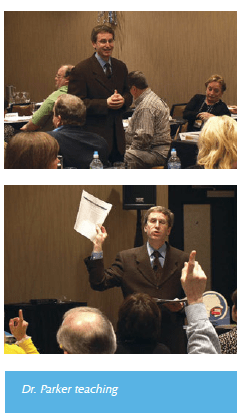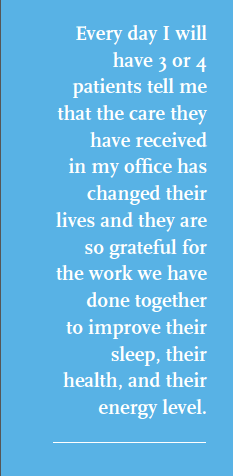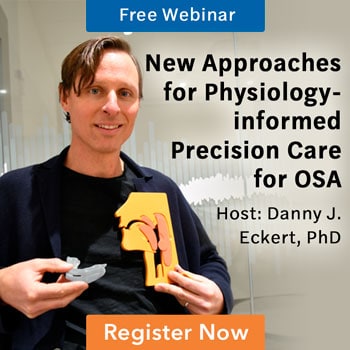 How did you learn to provide sleep services in your practice? Did you find the instructor at the courses you took inspiring? Did you see her/him as someone you could emulate? Over a career, dentists take hundreds of hours of education from dozens of instructors. How many do you remember? Have you made a difference in your patient’s lives because of what you learned?
How did you learn to provide sleep services in your practice? Did you find the instructor at the courses you took inspiring? Did you see her/him as someone you could emulate? Over a career, dentists take hundreds of hours of education from dozens of instructors. How many do you remember? Have you made a difference in your patient’s lives because of what you learned?
Chances are, if you’ve learned sleep medicine from Jon Parker, every answer will be positive, and you are having fun helping people get healthier in your community. Dental Sleep Practice sat down with Dr. Parker to explore what makes him one of the premier teachers of dental sleep medicine.
DSP: Dr. Parker, thank you for taking time to speak to me about your role in our profession. All good teaching is fueled by wisdom, which comes from experience. You see patients every day; what do you think is unique about your practice?
My practice intention is unique in the way that my team and I work together to create an exceptional patient experience. It is focused on guiding the patients through this experience of being cared for and of learning about their sleep, health, treatment options and about themselves. We are able to develop a relationship with them and educate them from the initial phone conversation through all phases of their treatment. We have also created a wonderful healing energy in our space/environment and patients are keenly aware of it from the moment they walk into the office. I want to empower them to make the right choices for themselves and I want them to feel good about their experience every step of the way in their treatment process.
DSP: Your practice is not just about making appliances for referred patients.
Our practice is about helping patients improve their sleep and their health. I have been influenced by a number of gifted holistic physicians and dentists who have created practices around developing a relationship with their patients in a way that helps them understand their health issues and guides them through a process of reclaiming their health and vitality. I have been influenced by many people in my professional career. I am inspired by practitioners who have taken a different path in their medical training and practice, understand the science and art of medicine at a deep level, and view the healing process in an integrative way. Deepak Chopra, MD and Bill Manahan, MD are both physicians who have inspired me to explore an integrative approach in medicine that helps the patient heal on a physical and consciousness level. I will have discussions with my patients about sleep, health and healing both physically and spiritually. In addition, guiding my patients who have chronic health conditions to practitioners who use this approach has been very helpful for them and very rewarding for me.
In dentistry, my colleagues (and friends) Drs. Alan Lowe and Rob Rogers, who are real pioneers in this area of dentistry, continue to kindle the fire in me to do this work and advance the art and science of dental sleep medicine.
My parents have also inspired me. My father was an internationally-known architect and my mother was a pre-school teacher. My father had a private practice and he taught at the University of Minnesota School of Architecture for 40 years. His unique teaching style and approach to architecture had a profound impact on architects around the world and he certainly influenced how I created my path in dentistry. They both instilled the important values that continue to guide me in my work and in my life.
DSP: Dentists you’ve taught, then, come away with more than ‘how to do’ appliance therapy.
Dental sleep medicine is much more than just fitting an oral appliance. We need to understand all aspects of sleep and the anatomy and physiology of the system we are managing. Since I have been fortunate enough to practice in dental sleep medicine for so many years, I believe it is my responsibility to teach and mentor others so they also have the chance to change people’s lives through this work. My practice is so rewarding for me that I want to help others enjoy their ‘work’ as much as I do.
I am disappointed with some of the teaching methods typically used in dentistry and other educational settings. So, I have tried to find unique ways of presenting and expressing the information that I am teaching by using visual, verbal, and written techniques to engage the audience. It is with this idea in mind that I created the animated video “An Overview of Sleep Medicine”. The video uses a white board format and it has been well received by dentists, physicians, and patients. People have said that they learned a lot and really enjoyed the entertaining way in which the information was presented. I believe we, as educators, need to find new and creative ways to deliver the information so the attendees at courses will learn and remember the material being taught and are able to apply it in their practices.
I have also tried my best to present the information in an unbiased way so it allows the attendees to make their own decisions about the various choices they have related to diagnosis and treatment of sleep-related breathing disorders.
I just hope my joy of teaching and my love of dental sleep medicine will shine through during my presentations so the audience feels that same spark within themselves. I want them to see how fun it is to work in this area of dentistry. There are so many people suffering from sleep apnea and we need more dentists out there helping them.
 DSP: Sounds like you’ve put as much ‘intention’ into your teaching as you do your practice. How did you come to this?
DSP: Sounds like you’ve put as much ‘intention’ into your teaching as you do your practice. How did you come to this?
The story of how I was introduced to sleep medicine is relatively simple. I grew up in Minnesota and received my undergraduate and dental degrees at the University of Minnesota. I took an elective course in “Management of TMDs” during my senior year in dental school and the dentist/professor who taught the course hired me in a part-time position in his TMD private practice in 1983. At the same time I was a part-time associate in a general dental practice. In 1990, my mentor in the TMD practice accepted a position at the University of Oklahoma and I bought the TMD practice from him and left the general dentistry practice to manage TMD patients on a full-time basis in my new practice. In 1992 I had a TMD patient, who was a technologist at the local sleep disorders center, tell me about a patient of theirs who had a sleep study while using a dental device and had great success with it. They had never seen an oral appliance so she invited me to come to their Wednesday staff meetings at the sleep center and this invitation started my journey into sleep medicine. I attended the staff meeting at the hospital sleep center every Wednesday (and still do—now the meetings are once per month) and met with the sleep medicine physicians who helped educate me and began referring patients to see me for oral appliance therapy.
After this initial exposure to sleep medicine, I went to the library and looked for articles on oral appliance therapy. However, it became clear that there was not a lot of research on this treatment approach. In 1992, I attended my first course on sleep medicine and dentistry that was presented by Alan Lowe, DDS and Melvin Lopata, MD in Chicago. It was so exciting for me to see that there was some science in sleep medicine that correlated the effects of sleep and breathing problems and the concept of oral appliance therapy had some support in the literature (although limited). I knew that although this discipline was in its infancy in dentistry it would give me an opportunity to help patients shift their health. After that course in Chicago, I couldn’t wait to get back to my office to start screening patients with questionnaires and eventually to begin treating them.
I incorporated dental sleep medicine into my TMD practice in 1992 and provided care for both conditions for about 8 years. The dental sleep medicine part of my practice grew steadily and in 2000, I made the choice to sell my part of the TMD practice to my partner and I created a full-time dental sleep medicine practice.
 DSP: How did you get involved in teaching sleep medicine? I remember my first AADSM meeting you were teaching the Introduction to Dental Sleep Medicine course.
DSP: How did you get involved in teaching sleep medicine? I remember my first AADSM meeting you were teaching the Introduction to Dental Sleep Medicine course.
My teaching career began in 1986 when I was asked to present on various TMD topics for local study clubs and at the Minnesota Dental Association “Star of the North” meeting. I continued to lecture solely on TMD issues until 1993 when I was invited by a dental laboratory company to lecture about dental sleep medicine to dentists in their community. A few months later I was invited to present on this topic at the Minnesota Dental Association meeting. From that time forward my lecture schedule started to grow as I received invitations from local study clubs, dental laboratories, and state and national dental associations.
I started lecturing at the Sleep Disorders Dental Society (now the AADSM) Annual Meeting in June 1994. The program committee asked me to chair the Introductory course “A Review of Dental Sleep Medicine” in June 2000 at the meeting in Las Vegas and I chaired that program for many years after that. We had a nice lineup of speakers and it was exciting for me to see that Review Course grow. The attendees seemed to be inspired by the presentations that were given. I believe that course was important for dentists who were just starting to explore dental sleep medicine and it was fun for me to be a part of it.
For the past 13 years, I have been teaching courses, 3 times per year, in my office to small groups of dentists and their staff. Also, I feel blessed to continue to give presentations to larger groups at study clubs, local, state and national dental association meetings in the US and internationally.
DSP: Teaching is hard work, and takes you away from your ‘normal life.’ What keeps you going?
What keeps me going and inspires me to teach and care for patients with snoring and sleep apnea is that it gives me a chance to be helpful to other people. I am grateful for the opportunity to assist patients directly by helping them sleep and breathe better and to improve their health through the work we do together. In addition, I am blessed to have the chance to teach other dentists to integrate dental sleep medicine into their practices and in this way I indirectly help many more people improve their health through the work of other dentists. It is a “ripple effect” and I never know who or how many others will be impacted by the teaching and interactions I have with dentists in a course.
 Dental sleep medicine has a bright future. It is estimated that only 5% of patients receiving treatment for OSA in the US are being treated with oral appliances. I believe that within 5 years about 30% of patients will be prescribed oral appliances for OSA. This means there will be incredible growth of this therapy in the future. The amount of research that is being published on oral appliance therapy is increasing dramatically and will continue to support this growth. In order for dental sleep medicine to remain viable we will need to maintain an ethical, patient-centered approach to managing the patients. Developing protocols for patient care in collaboration with our medical colleagues will be a key element in the development of this approach.
Dental sleep medicine has a bright future. It is estimated that only 5% of patients receiving treatment for OSA in the US are being treated with oral appliances. I believe that within 5 years about 30% of patients will be prescribed oral appliances for OSA. This means there will be incredible growth of this therapy in the future. The amount of research that is being published on oral appliance therapy is increasing dramatically and will continue to support this growth. In order for dental sleep medicine to remain viable we will need to maintain an ethical, patient-centered approach to managing the patients. Developing protocols for patient care in collaboration with our medical colleagues will be a key element in the development of this approach.
Although I really enjoy my work, what I love most is spending time with my wife, three children and three grandchildren. It is a joy for me to see how they are pursuing their lives and I really enjoy the time I have to spend with them. I have made the choices to spend time away from my family doing research, serving in the AADSM and ABDSM, and teaching largely because of what others have done for me over the years. I am grateful to those leaders who have moved this field forward and encouraged me along the way.
DSP: What are your top tips for adding DSM to a successful practice?
- Continue to expand your knowledge by finding good dental sleep medicine educational opportunities
- Educate your staff in the areas of direct patient care, practice management and insurance reimbursement so they can support you in growing this part of your practice.
- Collaborate with sleep medicine physicians and primary care physicians in managing your patients (build a good relationship with them)
- Gain expertise with multiple oral appliances so you can choose the appliance that best fits each patient’s situation.
- Join the AADSM and get involved in the organization. It will expand your knowledge and understanding of DSM and will build the relationships and support you need to grow this part of your practice
- When you are ready, complete the ABDSM certification exam and become a Diplomate. This will build your credibility in the sleep community and help your practice grow.
DSP: How do today’s practice challenges compare to your experience?
When I started in dental sleep medicine 23 years ago, I was viewed as a bit of a maverick for expanding into an area of dentistry that was not well known. In addition there was not very much research evidence available on oral appliance therapy at that time. I was challenged by my medical (and many of my dental) colleagues who questioned the effectiveness of oral appliance therapy. It has been difficult at times to convince my colleagues of the effectiveness of this approach to managing OSA patients. I have continued to update them on the research data as it has continued to grow and it has been very helpful in encouraging the physicians and dentists to refer patients for treatment.
Today’s dentists have a growing body of research evidence to support them as they approach their colleagues about being part of the solution for patients. However the landscape in health care is changing and there are challenges that exist now that were not as much of a concern when I started in this area of dentistry. The dentists involved in dental sleep medicine will need to create new systems for collaboration with physicians to grow their practices. In addition, they will need to educate themselves on the medical insurance protocols. Since the costs of care continue to rise, it will be important to develop affordable ways to manage the millions of patients who are in need of our services.
DSP: The rewards don’t only come from being paid, though, do they?
I really enjoyed my TMD practice, but I found the work with the patients who had sleep disorders to be even more rewarding. This has been the most satisfying part of my career in dentistry. Every day I will have 3 or 4 patients tell me that the care they have received in my office has changed their lives and they are so grateful for the work we have done together to improve their sleep, their health, and their energy level. I do not believe there is another area in dentistry that has this type of impact on people’s lives. So, I love going into the office each day. It is very fulfilling to do this work.
Visit www.dentalsleepology.com to learn about Dr. Parker and his educational courses.





